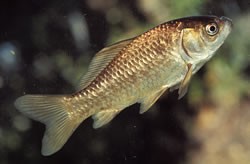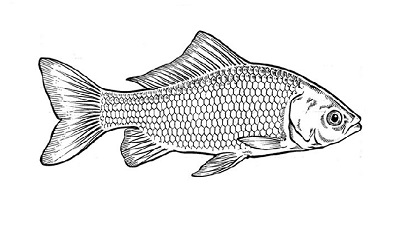Goldfish
Adult goldfish
© Queensland Government
© Queensland Government
Illustration of a goldfish
© Queensland Government
© Queensland Government
Goldfish are native to Asia, but have been imported to Australia for many years as a popular aquarium fish. Goldfish may be kept in aquariums or above-ground ponds that prevent their escape during time of high rainfall and flooding. You must not release goldfish into the wild or use them as bait, alive or dead. If you catch goldfish in the wild, humanely kill them and don't return them to the water.
Scientific name
Carassius auratus
Description
- Usually grows to around 36cm, sometimes up to 45cm.
- Usually lives for 9–10 years; can live up to 30 years.
- Bright yellow to silver, grey or black. Many are mottled.
- Colour is closely related to habitat.
- Often mistaken for carp, but unlike carp they lack barbels (whiskers) on corners of upper lip.
Habitat
- Subtropical, freshwater fish, but prefers cooler waters.
Distribution
- Native to Asia; now present world-wide.
- Introduced to Australia in 1876 as an aquarium fish.
- Widely distributed in streams, ponds and dams throughout the southern half of Australia.
- Found in south-east and south-west Queensland and the Fitzroy and Burnett catchments.
Life cycle
Breeding
- Reaches sexual maturity at about 3 years.
- Lays up to 1,000 eggs on submerged vegetation.
- Eggs hatch in 5–6 days.
Diet
- Plants, small crustaceans, insects and detritus (organic debris).
Impacts
- Introduced to Australia as aquarium fish; once released, colonised many Australian freshwater systems.
- In the 1970s, goldfish were carriers of goldfish ulcer disease from Japan to Australia. The disease is bacterial and affects wild and captive goldfish and koi carp throughout south-eastern Australia. The disease has not yet affected any Australian native fishes.
- A potential pest, with several countries reporting adverse ecological impacts after they were introduced.
- Have not formed large populations, unlike carp.
Control
- If you catch goldfish in the wild, humanely kill them and do not return them to the water. Report all invasive fish captures through our online reporting form. Take photos, if possible.
Legal requirements
- Under the Biosecurity Act 2014 everyone has a general biosecurity obligation (GBO) to take reasonable and practical steps to minimise the risks associated with spreading or introducing pest fish. This includes any fish that is not native to Australia.
- To ensure you have met your GBO
- don't stock non-native fish in outdoor ponds
- don't release aquarium fish or aquarium water into waterways
- do what you reasonably can to stop a potential biosecurity threat from spreading. This could include reporting the issue to Biosecurity Queensland.
Further information
- Biosecurity Act 2014 and Biosecurity Regulation 2016
- Grant, EM 1997, Grant's guide to fishes, EM Grant Pty Ltd, Brisbane
- Managing the biosecurity risk of ornamental aquarium fish in Queensland fact sheet (PDF, 2.1MB)
- FishBase—a global information system on fishes

